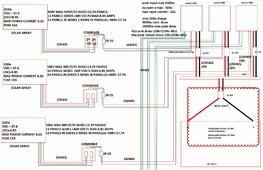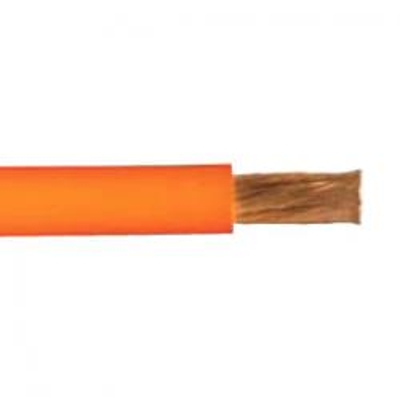I have attached a sketch of my system schematic. I do not have this system built yet but it shows all the inverters, batteries, and panels I currently have. My biggest challenge I have is determining the right wire size from the inverters to the battery bank. When I am running the calculations, I don't know if I should use the continuous output rating or the max peak power rating. Each inverter is rated at 5000w output with a 10000w peak output. 125A max battery discharge and 100a max charge rate. If each inverter is rated at 100a does that mean I could theoretically put 300a into the battery at one time? Not that I would need to charge with that much current at this time but it just a future thought of being rated to do so and how to size the wire accordingly. Also feel free to critique any of my breakers or basically anything else as nothing is locked in stone yet.
This is what I currently have sized.
Inverter to buss bar-125A max discharge rate x 1.25 = 156amps
10ft of cable at 156a calls for 2/0 wire.
Buss bar to battery (THIS IS WHERE I AM LOST ON WIRE SIZING)
15000W total between three inverters-15000w/48v=312a x 1.25 = 390a
I cannot find a wire that would allow for this type of amperage at least in the calculators I am finding. What size do I use or am I calculating wrong? I understand that I will not be pulling or should not be pulling all 15000w at one time but I figure theoretically that's what you calc for. Running the wire size calc i have to drop all the way to 230 amps for it to show that 4/0 is acceptable.


This is what I currently have sized.
Inverter to buss bar-125A max discharge rate x 1.25 = 156amps
10ft of cable at 156a calls for 2/0 wire.
Buss bar to battery (THIS IS WHERE I AM LOST ON WIRE SIZING)
15000W total between three inverters-15000w/48v=312a x 1.25 = 390a
I cannot find a wire that would allow for this type of amperage at least in the calculators I am finding. What size do I use or am I calculating wrong? I understand that I will not be pulling or should not be pulling all 15000w at one time but I figure theoretically that's what you calc for. Running the wire size calc i have to drop all the way to 230 amps for it to show that 4/0 is acceptable.







